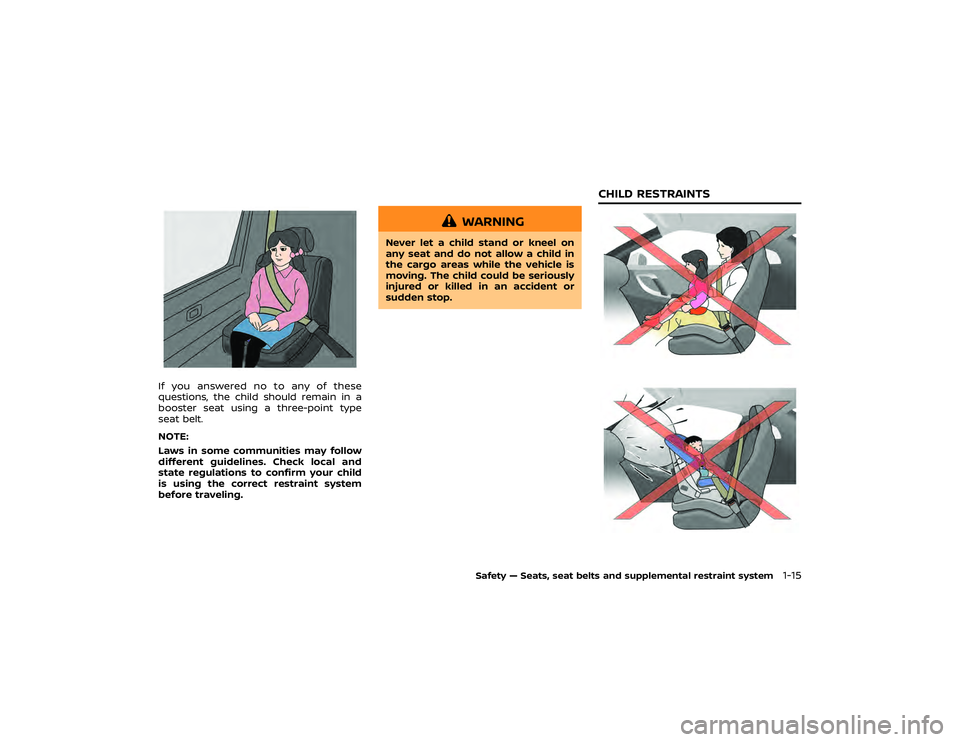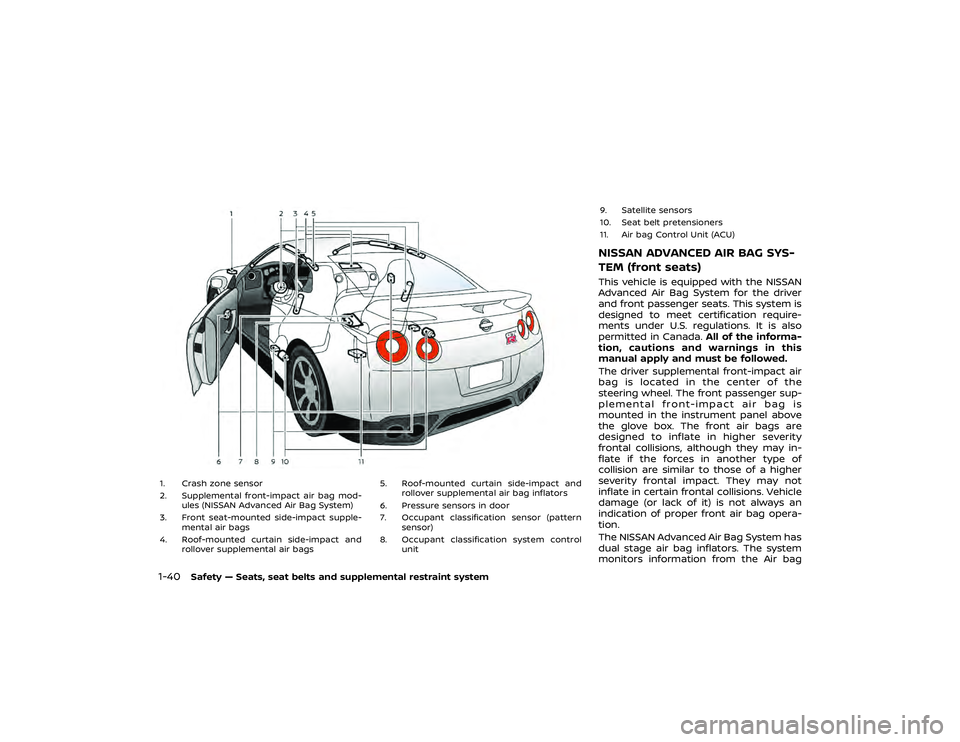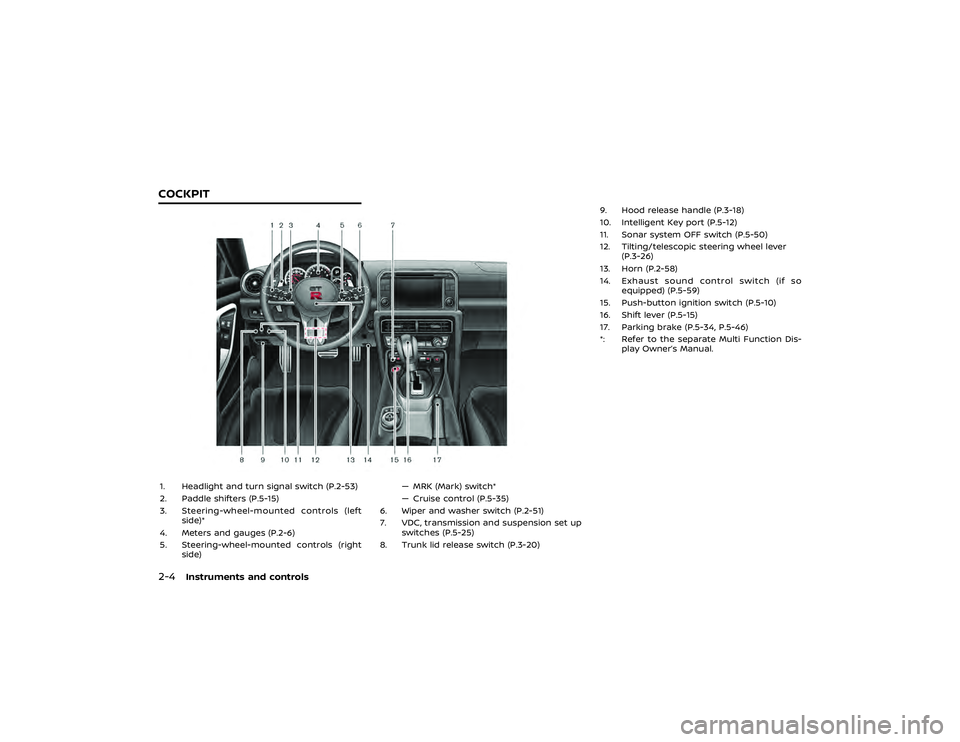engine NISSAN GT-R 2022 User Guide
[x] Cancel search | Manufacturer: NISSAN, Model Year: 2022, Model line: GT-R, Model: NISSAN GT-R 2022Pages: 1808, PDF Size: 4.88 MB
Page 62 of 1808

in this section for 48 hours after tires
are installed on the wheels. The tire
may slip on the wheel if the vehicle is
driven in these conditions before 48
hours have passed. If the tire slips on
the wheel, the wheel/tire assembly
will be out of balance and will require
rebalancing.
BrakesThe information and specifications in
this section apply only when engaging
in performance driving.
.Check for the heat deterioration of the
brakes and parts around the brakes.
. It is recommended that you remove
air from the brake system after any of
the following:
— When engaging in high perfor-
mance driving for the first time
after purchasing a new vehicle.
— After replacing the brake fluid.
— When engaging in high perfor- mance driving for a sustained per-
iod of time. It is recommended that
bleeding the brake be performed
when the brake calipers are hot
(about 212°F (100°C)). Brake pad break-in procedure:
NISSAN recommends that a special brake
pad break-in procedure be performed
before engaging in performance driving.
It is recommended you contact a GT-R
certified NISSAN dealer for details.
INSPECTION AND ADJUSTMENTS
AFTER DRIVINGThe information and specifications in
this section apply only when engaging
in performance driving.
NOTICE
At the completion of performance
driving, all fluid and other adjust-
ments should be returned to the
normal fluid specifications as shown
in the “8. Do-it-yourself” section of
this manual.FluidsThe information and specifications in
this section apply only when engaging
in performance driving.
.
Check the engine, transmission, differ-
ential and under the vehicle for oil and
coolant leaks. .
Check the fluid levels and adjust as
necessary using the specified fluid as
described under the conditions listed
in this section. (
“Recommended
fluids and maintenance interval” page
GTR-20) If you do not drive under the
conditions listed, refer to the “9. Main-
tenance and schedules” section of this
manual.
. When changing fluids, be sure to use
the specified fluids as described in this
Owner’s manual. (“Capacities and
recommended fluids/lubricants” page
10-2)
GT-R Overview
GTR-19
Page 68 of 1808

WARNING
Do not attempt to top off the fuel
tank after the fuel pump nozzle
shuts off automatically. Continued
refueling may cause fuel overflow,
resulting in fuel spray and possibly a
fire. The fuel tank is full at the first
automatic shutoff.
To maximize vehicle performance, the
fuel tank is located as low as possible to
lower the vehicle center of gravity. The
tank is also divided into two parts. This
fuel tank design causes higher pressures
inside the tank than other vehicles so fuel
spillage is possible by trying to top off the
fuel tank after automatic shutoff.
The fuel tank pressure is higher when the
vehicle is hot, especially if the tank is more
than half full. If the cap is opened when
the vehicle is hot, it may cause fuel spray
and there may be a hissing noise. Open
the cap slowly, releasing the pressure
from the tank gradually. Also, if the
vehicle is refueled when the vehicle is
hot, the fuel pump may automatically
shut off before the tank is full. This does
not indicate that there is a malfunction. Refuel slowly or refuel after the vehicle
has cooled.
GASOLINE SMELLThe fuel temperature is higher when the
vehicle is hot. This may cause a gasoline
smell from the vehicle. This does not
indicate that there is a malfunction. The
smell will go away when the fuel tem-
perature has cooled.OUTSIDE TEMPERATURE DISPLAY
INDICATES HIGHER TEMPERATUREHeat from the engine compartment, ra-
diator and intercoolers can affect the
outside temperature display. The outside
temperature display may indicate a high-
er than actual temperature while driving
or stopped. This is normal.IDLE SPEED IS NOT STEADYThe idle speed may not be steady when
the engine compartment is extremely
hot. This is normal. The engine speed will
be steady when the engine cools down.
In this case, the Malfunction Indicator
Light (MIL) may come on. After a few
driving trips, the MIL should turn off. If the
light remains on after a few driving trips, it
is recommended you have the vehicle
inspected by a GT-R certified NISSAN
dealer.
GT-R Overview
GTR-25
GT-R SPECIFIC VEHICLE CHARACTERISTICS
Page 69 of 1808

or
position: The maximum
engine speed is 4,300 RPM
. Revving the engine when the engine
oil is at a low (below 32°F (0°C)) or
extremely high (over 275°F (135°C))
temperature: The maximum engine
speed is 4,000 RPM (The
position
will automatically change to the
position.)
ENGINE OUTPUT
High altitudeTo protect the engine, engine output is
controlled so that it does not increase at
altitude of approximately 3,281 ft (1,000
m) or higher.Engine output according to the
coolant temperatureThe engine output is controlled at a low
level when the engine coolant tempera-
ture is lower than approximately 158°F
(70°C) or higher than 230°F (110°C). This is
not a malfunction. If the temperature is lower than approxi-
mately 158°F (70°C), drive the vehicle until
it reaches normal operating temperature.
If the temperature is higher than 230°F
(110°C), perform cool-down driving proce-
dure. (
“Cool down” page GTR-14)
When the temperature of the engine
coolant is between 158°F (70°C) and
230°F (110°C), the engine output returns
to normal.
UNEVEN WEAR OF TIRESThe GT-R is equipped with high perfor-
mance, low profile, run-flat tires that are
optimized for performance and handling.
The life of these tires will be less than
those of tires installed on a typical vehicle,
and you are likely to experience uneven
tire wear and tire noise regardless of the
type of tire used.NOISES ARE HEARD WHILE DRIV-
ING
Page 75 of 1808

to
position before the vehicle stops, you may not be able
to shift gear or it may take longer to shift gear. Make sure to depress the brake pedal and check that the vehicle has
stopped before shifting.
Multiple-disc wet
clutch
.
When stopping the vehicle with the shift lever in the
orposition. Move the shift lever after turning off the system check
display. Also, it is normal to hear clicking noises during the transmission systems check.
Changing modes
.
The higher shift speeds in the
position may result in shift shock and jerkiness when starting or shifting.
.
The quickest shifting in the R mode with the transmission in the
position is available when the engine speed is high.
However, the transmission may shift more slowly when the engine speed is low.
Mechanical Limited Slip
Differential (LSD) If the vehicle accelerates from a stop with the steering wheel turned half a turn in cold temperatures, the inner wheel tire
may slip and some noise or vibration may be heard. This phenomenon occurs because the viscosity of the differential oil
becomes thicker and the Limited Slip Differential (LSD) operates with increasing load. When the steering wheel is returned
to the straight ahead position or the differential oil warms up, the noise and vibration decrease.
Page 78 of 1808

0 Illustrated table of contentsSeats, seat belts and Supplemental Restraint
System (SRS).................................................................................... 0-2
Front ................................................................................................ 0-2
Rear .................................................................................................. 0-3
Exterior front ................................................................................... 0-4
Exterior rear ..................................................................................... 0-6 Passenger compartment ...................................................... 0-7
Cockpit ................................................................................................ 0-8
Instrument panel ........................................................................ 0-9
Meters and gauges ................................................................ 0-10
Engine compartment ........................................................... 0-11
Warning and indicator lights .......................................... 0-12
Page 94 of 1808

NOTICE
.When the temperature of the
engine coolant and transmission
oil is high or low, the function
cannot be used. The temperature
range in which the R mode start
function can be used:
— Engine coolant: 140°F - 212°F
(60°C - 100°C)
— Transmission oil: 140°F - 266°F (60°C - 130°C)
. If the R mode start function is
used 4 times consecutively, the
function may be disabled and
cannot be turned on to protect
the vehicle system. While the function is disabled, the warning
light illuminates. When the warn-
ing light illuminates, perform cool
down driving. (
“Cool down”
page GTR-14) When the warning
light turns off, the function can be
used again.
. The performance of start may
vary depending on the amount
of wheel spin ,or increase and
decrease of the engine output in
response to the outside tempera-
ture. (This vehicle was set up
according to the road surface
conditions of the straight sec-
tions of the Sendai Highland Ra-
ceway course in Japan at 59°F
(15°C).)
. For safety reasons, VDC control
may activate automatically when
driving on a slippery road surface,
such as a wet road, in order to
apply the brakes or limit the
engine output.
. Frequent use of the R mode start
function increases the load on
the powertrain related parts such
as the clutch and transmission
compared to normal driving. In
particular, the clutch will wear out
Starting and driving
5-33
R MODE START FUNCTION
Page 96 of 1808

Do not use the cruise control when
driving under the following condi-
tions. Doing so could cause a loss of
vehicle control and result in an acci-
dent.
.When it is not possible to keep
the vehicle at a set speed.
. In heavy traffic or in traffic that
varies in speed.
. On winding or hilly roads.
. On slippery roads (rain, snow, ice,
etc.).
. In very windy areas.
NOTE:
. When the SAVE mode is selected
with the transmission setup switch,
the acceleration and deceleration
can be controlled smoothly. When
the SAVE mode is selected, the
maximum setting speed is lower
than the one in the normal mode. When the vehicle approaches a gen-
tle uphill, there may be a slight delay
as the vehicle returns to the preset
speed. However, the vehicle will
gradually accelerate and return to
the preset speed.
PRECAUTIONS ON CRUISE CON-
TROL.
If the cruise control system malfunc-
tions, it will cancel automatically. The
SET indicator will blink and the cruise
control system warning will appear to
warn the driver. (
“Cruise control
system warning” page 2-43)
. If the engine coolant temperature
becomes excessively high, the cruise
control system will be canceled auto-
matically.
. If the SET indicator blinks, turn the
cruise control main switch off and it is
recommended you contact a GT-R
Starting and driving
5-35
CRUISE CONTROL
Page 104 of 1808

is started.
If any malfunction occurs in the AWD
system while the engine is running, the
warning light will come on.
The warning light may blink rapidly
(about twice per second) while trying to
free a stuck vehicle due to high AWD
clutch temperature. The driving mode
may change to two-wheel drive. If the
warning light blinks rapidly during opera-
tion, stop the vehicle with the engine
idling in a safe place immediately. Then if
the light goes off after a while, you can
continue driving.
A large difference between the diameters
of front and rear wheels will make the
warning light blink slowly (about once per
two seconds). Pull off the road in a safe
area, and idle the engine. Check that all
tire sizes are the same, tire pressure is
correct and tires are not worn and winter
tires are not installed on the front or rear
wheels only.
If the warning light is blinking after the
above operation, it is recommended you
have your vehicle checked by a GT-R
certified NISSAN dealer as soon as possi-
ble.
If non-genuine GT-R tires are used, the
warning light may illuminate. (
Page 105 of 1808

TIGHT CORNER BRAKING PHE-
NOMENONIf the steering wheel is turned more than
half a turn when the vehicle is started
when it is cold, it may be harder to move
the vehicle forward and backward. This
phenomenon is known as the “tight
corner braking phenomenon”.
This phenomenon is unique to AWD
vehicles, and occurs due to a difference
in speeds between the front and rear
wheels while the vehicle is turning. This
does not indicate that there is a malfunc-
tion.
NOTE:
If the tight corner braking phenomenon
occurs, a slipping sound may be heard
from the tires, or a squeaking sound
may be heard from the drive system.Reducing tight corner braking
phenomenonThe tight corner braking phenomenon
can be reduced if the following three
conditions are met:
.Transmission setup switch is set to
Normal mode.
. Vehicle speed is low (less than ap-
proximately 6 MPH (10 km/h)). .
The steering wheel is turned more
than 1/2 turn.
TIRESThis vehicle is equipped with special tires.
When changing the tires, install the de-
signated special tires. Replacing tires as a
set of four with new ones is recom-
mended. However, if a tire is punctured
or damaged, it may be possible to replace
only the damaged tire. Determining
whether one tire or a complete set of
tires should be replaced is based on a
number of factors including tire wear and
condition. Contact your GT-R certified
NISSAN dealer. They can recommend if
an individual tire or a complete set should
be replaced.
NOTICE
If tires other than the designated
tires, tires with large differences in
wear or tires of different sizes are
installed, the AWD performance will
be degraded and the drive mechan-
ism may be damaged.
AWD SYSTEM CHARACTERISTICSThe AWD system automatically distri-
butes the optimal torque to the front
and rear wheels. This provides both the
superior turning performance of a rear
wheel drive vehicle and the traction of a
AWD vehicle.
Electronic control continuously distri-
butes torque to the front and rear wheels
in the range from 0:100 (rear-wheel drive
mode) to 50:50 (all-wheel drive mode) to
match the driving conditions and road
conditions. This allows the engine output
(torque) to be effectively transmitted to
the road surface.
Page 108 of 1808

position.
3. To help prevent the vehicle from roll- ing into the street when parked on a
sloping drive way, it is a good practice
to turn the wheels as illustrated.
.
HEADED DOWNHILL WITH CURB:Turn the wheels into the curb and
move the vehicle forward until the
curb side wheel gently touches the
curb.
.
HEADED UPHILL WITH CURB:Turn the wheels away from the
curb and move the vehicle back
until the curb side wheel gently
touches the curb.
.
HEADED UPHILL OR DOWNHILL, NO
CURB:Turn the wheels toward the side of
the road so the vehicle will move
away from the center of the road if
it moves.
4. Push the ignition switch to the LOCK position.
For models without NCCB (NISSAN Car-
bon Ceramic Brake) package:
The GT-R uses brake pad materials that
have high metallic content. The brake pad
material helps maintain braking perfor-
mance in a wide range of weather and driving conditions.
For the first 3,000 - 6,000 miles (5,000 -
10,000 km) of the vehicle’s service life, and
for the first 3,000 - 6,000 miles (5,000 -
10,000 km) after a brake replacement, the
brake pad to brake rotor clearance is very
small. When parking, apply the parking
brake and move the shift lever to the
position. Idle the engine for more than 20
seconds without depressing the brake
pedal. This allows the brake pads to move
away from the rotor so the pad does not
contact the rotor.
Additionally, the brakes must be dry
before parking the vehicle after driving
on wet roads or after washing the vehicle.
If the roads are wet, lightly apply the
brakes for a short distance before parking
the vehicle to dry the brakes. After wash-
ing the vehicle, dry the brakes by driving
on a dry road for a few miles and apply
the brakes normally based on traffic and
road conditions.
The metallic brake pads and brake disc
rotor may rust together when the brakes
are not applied:
.
If the vehicle is not idled for 20
seconds without the brakes applied,
or if the brakes are applied when the
vehicle is shut off, the rotor and pads
can rust together, even when the brake pads are dry.
. If the brakes are wet when the vehicle
is parked and the parking brake is
applied for a long time.
It is recommended you contact a GT-R
certified NISSAN dealer if the brake pads
and brake rotor have rusted together.
For models with NCCB (NISSAN Carbon
Ceramic Brake) package:
(
“NCCB (NISSAN Carbon Ceramic
Brake)” page 8-20)
Starting and driving
5-47